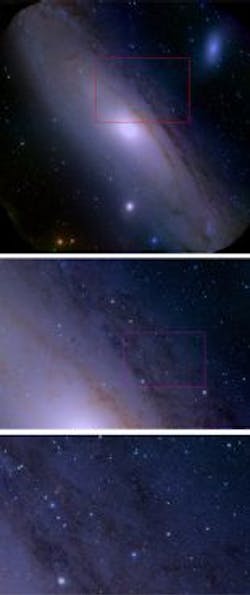Subaru Telescope camera captures brilliant images of Andromeda Galaxy
An enormous wide-field camera aboard the Subaru Telescope has captured images of the Andromeda Galaxy. Known as the Hyper-Suprime Cam, the camera will enable researchers to perform a “cosmic census” of hundreds of millions of galaxies.
The first of the Hyper-Suprime Cam system’s three main components is the actual camera, according to the Subaru Telescope website. The camera consists of a lens, filters, shutter, and light sensors. It also features a highly-sensitive, 870MPixel CCD image sensor. The CCD array is installed inside a vacuum cryogenic dewar and is operated at -100°C. Newly developed in collaboration with the National Astronomical Observatory of Japan (NAOJ) and Hamamatsu Photonics, the CCD sensor features a focal plane that is 60 cm in diameter.
A wide field corrector lens comprises the second major component of the Hyper-Suprime Cam. The diameter of the first lens is 82 cm and the length of the lens barrel is 165cm. The glass selection in the lens combines quartz from US Corning and two kinds of optical glass from JP Ohara. The wide field corrector lens corrects aberrations that occur on the primary mirror located 16m below the camera.
The third and final major component of the system is the prime focus unit, which is a chassis that holds the camera and the wide field corrector lens. The prime focus unit is mounted on the inner hub of the top ring of the telescope.
With the Hyper-Suprime Cam, researchers will be able to probe mysteries such as dark matter and dark energy, while also searching for baby galaxies in the early universe. The images of the Andromeda Galaxy—which is approximately 60,000 light years across—were produced in a single shot, demonstrating the enormous field of view of the camera. Michael Strauss, a Princeton professor of astrophysical sciences who is involved in processing Hyper-Suprime Cam images, said in a press release that the system will help scientists understand the nature and history of galaxies.
“We are very excited about using this survey to study the nature of galaxies in the distant past," he said. "Because of the finite speed of light, we see these galaxies as they were billions of years ago, and we will compare the properties of galaxies in their youth to the mature galaxies we see around us today."
The Hyper-Suprime Cam is the result of an international collaboration between the NAOJ, Kavli IPMU, the School of Science at the University of Tokyo, KEK (High Energy Accelerator Research Organization, Japan), Academia Sinica Institute of Astronomy and Astrophysics in Taiwan and Princeton — and with technology companies Hamamatsu Photonics., Canon Inc. and Mitsubishi Electric Corporation.
View the Princeton press release.
View more information on the Subaru telescope.
Also check out:
Spitzer Space Telescope's images of gas emission from Comet ISON
NASA releases image of Saturn's view of Earth
Largest camera in the world to create 3D map of Milky Way
Share your vision-related news by contacting James Carroll, Senior Web Editor, Vision Systems Design
To receive news like this in your inbox, click here.
Join our LinkedIn group | Like us on Facebook | Follow us on Twitter | Check us out on Google +
About the Author

James Carroll
Former VSD Editor James Carroll joined the team 2013. Carroll covered machine vision and imaging from numerous angles, including application stories, industry news, market updates, and new products. In addition to writing and editing articles, Carroll managed the Innovators Awards program and webcasts.
